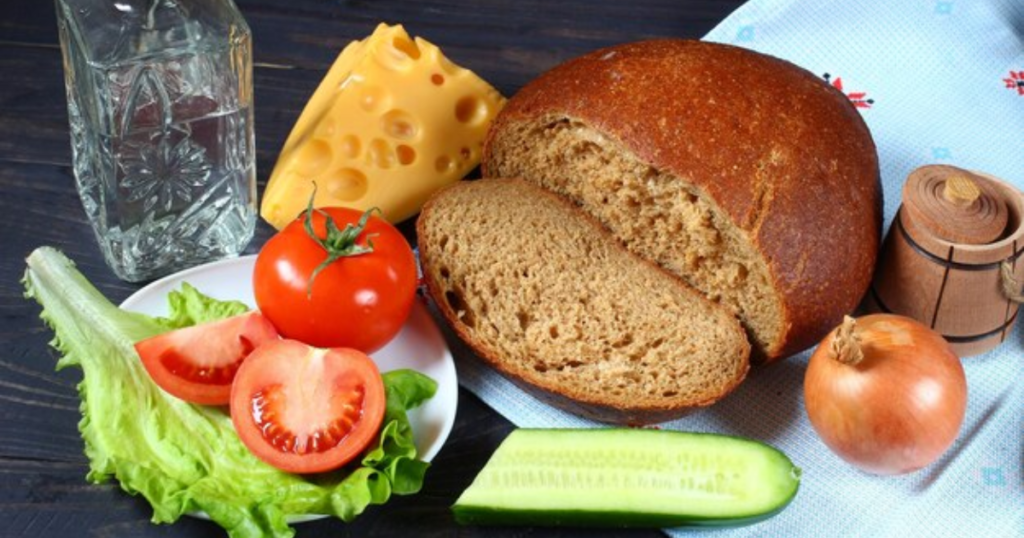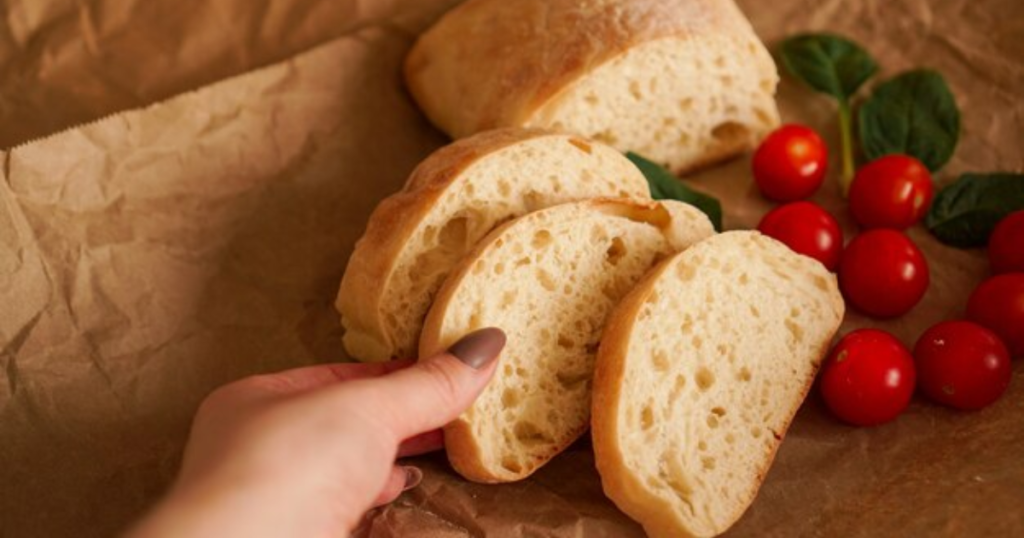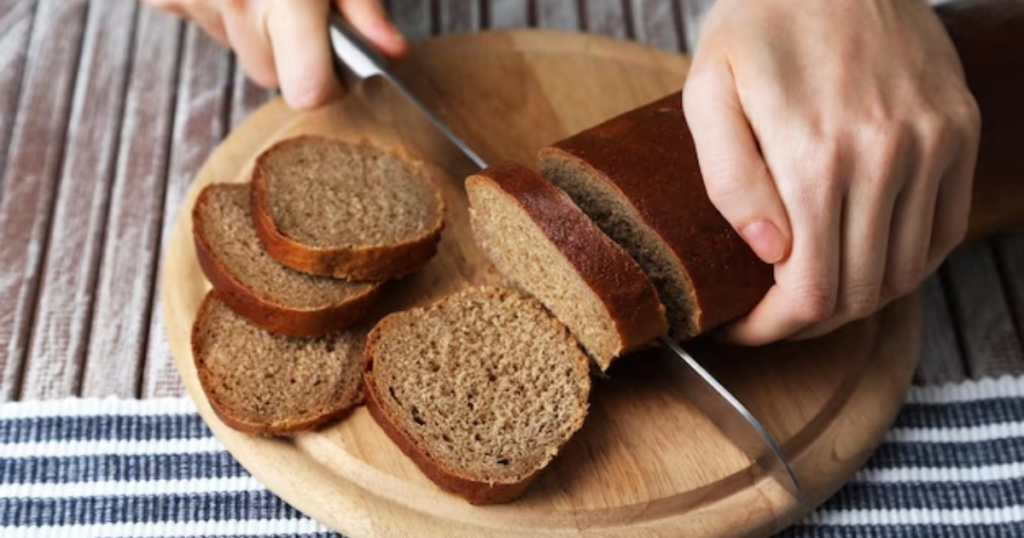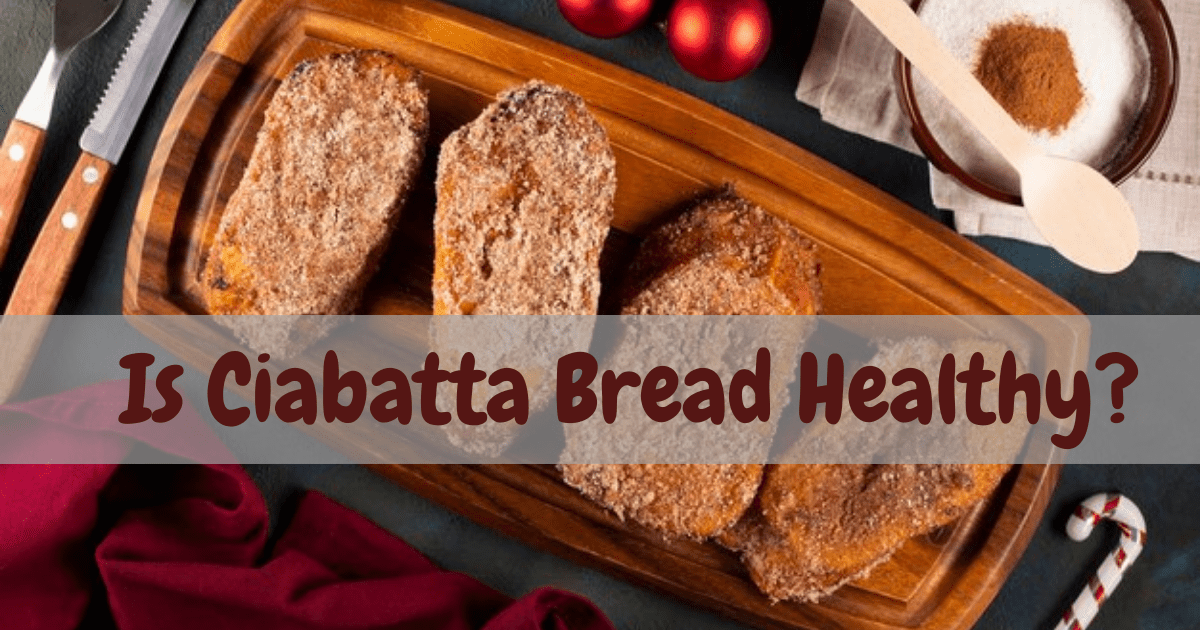Ciabatta bread, with its rustic appearance and chewy texture, has become a popular choice in many homes and restaurants. This bread, which originated in Italy, has become renowned around the world due to its versatility and great taste. But, is ciabatta bread a healthy option? Let’s look at its nutritional profile to find out.
What is Ciabatta Bread?
Ciabatta is an Italian white bread made with wheat flour, water, salt, and yeast. It is notable for its elongated shape and uneven, hole-filled crumb. The crust is normally crisp and golden brown, while the interior is airy and chewy. Ciabatta is commonly used to make sandwiches, particularly paninis, due to its firm structure and ability to hold contents without becoming soggy. It’s a popular choice at bakeries and restaurants all across the world.
Nutritional Value of Ciabatta Bread
The nutritional content of ciabatta bread varies according to the recipe and components used. However, below is a broad review of the nutritional value of a normal serving (one slice, around 50 grammes) of ciabatta bread.
- Calories: Approximately 130-150 calories
- Carbohydrates: Around 25-30 grams
- Protein: About 4-6 grams
- Fat: Usually less than 1 gram
- Fiber: Approximately 1-2 grams
Ciabatta bread is generally prepared with wheat flour, which contains carbohydrates, protein, and fibre. It contains little fat and no cholesterol. However, the sodium level varies depending on the amount of salt used in the baking process.

Homemade Recipes for Making Healthy Ciabatta Bread
Understanding the Ingredients
Before we get started on the recipe, let’s go over the important elements needed to make true ciabatta bread:
1. Flour:
The basis of any bread, flour selection is critical for ciabatta. Choose high-quality bread flour, which includes more gluten, resulting in superior structure and texture.
2. Yeast:
Yeast is responsible for leavening the bread, resulting in the desired air pockets and light, airy crumb. Ciabatta can be baked using either active dry yeast or quick yeast.
3. Water:
The dough’s moisture level is critical in generating ciabatta’s distinctive open crumb structure. Use lukewarm water to activate the yeast and produce gluten.
4. Salt:
Salt not only improves flavour but also controls the fermentation process. It enhances the gluten network and reduces yeast activity, allowing for more flavour development.
Step-by-Step Recipe for Healthy Ciabatta Bread
Now that we’ve covered the necessary ingredients, let’s get into the complete method for making great ciabatta bread at home:
1. Prepare the Starter:
- In a small basin, add 1/4 teaspoon yeast and 1/2 cup lukewarm water.
- Stir in 1 cup bread flour until the dough is thick and sticky.
- Cover the bowl with plastic wrap and leave to ferment at room temperature for 12-16 hours, or until bubbling and double in size.
2. Mix the Dough:
- In a large mixing bowl, add 2 cups bread flour and 1 teaspoon salt.
- Make a well in the centre and pour in the starting mixture, along with another 3/4 cup of lukewarm water.
- Using a wooden spoon or your hands, stir until a shaggy dough forms.
3. Knead and Ferment:
- Turn the dough out on a floured surface and knead for 8-10 minutes, or until smooth and elastic.
- Place the dough in a lightly oiled basin, cover with a clean kitchen towel, and leave to rise for 2-3 hours, or until doubled in size.
4. Shape the Loaves:
- Gently deflate the dough and divide it in two equal parts.
- Form each half into a rectangle, then fold the sides towards the centre to create a rough oval shape.
- Transfer the loaves to a baking sheet lined with parchment, seam side down.
5. Final Proofing:
- Cover the loaves with a moist kitchen towel and leave to prove for 1-2 hours, or until puffy and slightly risen.
6. Bake to Perfection:
- Preheat the oven to 450°F (230°C), and place a shallow pan on the lowest rack.
- Just before baking, dust the loaves with flour and cut many diagonal slashes on top.
- Quickly place the baking sheet in the oven and pour a cup of hot water into a small pan to generate steam.
- Bake for 25-30 minutes, or until the ciabatta turns golden brown and sounds hollow when tapped on the bottom.

What Are the Health Benefits of Ciabatta?
Ciabatta bread, with its airy texture and wonderful flavour, not only entices the taste buds but also provides numerous health benefits. Let’s look at the healthy benefits of including ciabatta bread into your diet.
1. Lower in Fat:
Ciabatta bread often includes low amounts of fat, making it a healthier alternative than many other types of bread. This lower fat level may be advantageous for people trying to control their overall fat intake.
2. Good Source of Carbohydrates:
Ciabatta, being a carbohydrate-rich food, provides a rapid source of energy, making it an ideal choice for fuelling your body before physical activity or as part of a balanced diet.
3. Moderate Fiber Content:
While not as high in fibre as whole grain bread, ciabatta contains a modest level of dietary fibre, which can ease digestion and enhance feelings of fullness, potentially helping with weight management.
4. Rich in Minerals:
Ciabatta bread contains critical elements like iron, magnesium, and selenium, which are necessary for a variety of body activities such as oxygen transfer, muscle function, and antioxidant defence.
5. Versatile for Healthy Toppings:
Ciabatta is a versatile base for adding nutritious toppings such as fresh veggies, lean proteins, and heart-healthy fats like avocado or olive oil. Ciabatta can be paired with healthful components to create balanced and delicious meals.
6. Lower Sodium Option:
When made at home, ciabatta bread allows you to manage the sodium concentration, allowing you to make a lower sodium choice than other store-bought bread variants. Reduced salt intake can help with heart health and blood pressure management.
Potential Side Effects of Ciabatta Bread
Ciabatta bread can cause different reactions in people depending on their health or diet. Here are some things that might happen if you eat ciabatta:
- Gluten Sensitivity or Celiac Disease: Ciabatta has gluten from wheat, which can make some people feel sick if they have problems with gluten. They might feel bloated, have stomach pain, diarrhea, or feel tired.
- Wheat Allergy: Some people are allergic to wheat proteins. If they eat ciabatta, they could get hives, itching, swelling, have trouble breathing, or even have a serious allergic reaction.
- Too Many Carbs: Ciabatta has a lot of carbohydrates, which can make your blood sugar go up quickly. This could be a problem for people with diabetes or if you’re not active enough. Eating too much ciabatta could also make you gain weight.
- Tummy Troubles: Ciabatta’s high carb and gluten can upset some people’s stomachs, especially if they have conditions like IBS. They might feel gassy, bloated, crampy, or get diarrhea.
- Salt: Some ciabatta recipes have added salt, which can be bad for your heart if you eat too much, especially if you already have high blood pressure or heart problems.
- Weight Gain: Ciabatta has a lot of calories, especially if you eat a lot of it with fatty things like butter or cheese. This could make you gain weight.
- Teeth: Ciabatta can stick to your teeth and cause cavities if you don’t brush well.
Remember, not everyone will have these problems, and some people can eat ciabatta without any issues. But if you’re worried about your health or if you have any of these conditions, it’s a good idea to talk to a doctor or a dietitian. They can give you advice that’s just right for you.
7 Popular Ciabatta Breads
1. Traditional Ciabatta:
The typical ciabatta bread has a rustic appearance, with a crispy top and huge, irregular air pockets in the crumb. Traditional ciabatta, made from simple ingredients like as flour, water, yeast, salt, and olive oil, is ideal for sandwiches, bruschetta, and dipping in olive oil and balsamic vinegar.
2. Whole Wheat Ciabatta:
Whole wheat ciabatta is becoming increasingly popular among health-conscious consumers. This variant, made with whole wheat flour, keeps the ciabatta’s distinctive texture while providing more fiber and nutrients.
3. Herb Ciabatta:
Herb ciabatta, infused with aromatic herbs like rosemary, thyme, and basil, gives a burst of flavor to any meal. Herbs are often included into the dough during the mixing process, yielding a fragrant and savory bread that goes well with cheeses, roasted vegetables, or charcuterie.
4. Olive Ciabatta:
Olive ciabatta is a tasty treat for those who enjoy olives. Whole or chopped olives are added into the dough, providing a salty flavor to the bread. Slice and toast olive ciabatta, top with tapenade, and serve with Mediterranean-inspired foods.
5. Cheese and Onion Ciabatta:
This savory ciabatta version, which combines the rich flavors of cheese and caramelized onions, is a crowd favorite. Gooey melted cheese and fragrant onions lend depth to the bread, making it ideal for gourmet grilled cheese sandwiches or as a side dish to soups and salads.
6. Multigrain Ciabatta:
Multigrain ciabatta adds a healthful twist to the standard recipe by combining whole grains and seeds like oats, flaxseeds, and sunflower seeds. This robust bread has a pleasing crunch and nutty flavor, making it great for sandwiches or as a side dish with stews and casseroles.
7. Sourdough Ciabatta:
Sourdough fans will enjoy the tangy flavour and chewy texture of sourdough ciabatta. This version, which uses a sourdough starter rather than commercial yeast, ferments for a longer period of time, resulting in improved flavour and digestibility.

Comparison with Other Breads
There are noticeable distinctions between ciabatta and other forms of bread, such as whole grain or sourdough. Whole grain breads contain the full grain kernel, which provides more fiber, vitamins, and minerals than refined flour breads such as ciabatta. Sourdough bread is fermented with lactobacilli, which may have extra health benefits like enhanced digestion and nutrient absorption.
How to Include Ciabatta in Your Diet?
Ciabatta bread is yummy and can be used in many different ways to add good stuff to your meals. Here are some simple ideas:
- Sandwiches: Put your favorite things like veggies, meat, cheese, and greens between slices of ciabatta for a tasty sandwich.
- Toast: Toast ciabatta slices and put avocado, hummus, tomatoes, salt, and olive oil on top for a quick and yummy snack.
- Bruschetta: Toast ciabatta and add tomatoes, garlic, basil, and olive oil for a yummy Italian appetizer.
- Panzanella: Make a salad with ciabatta, tomatoes, cucumbers, onions, basil, and dressing for a crunchy and tasty meal.
- Garlic bread: Spread melted butter, garlic, and herbs on ciabatta slices, then toast them for a tasty side dish.
- Crostini: Toast thin slices of ciabatta and add toppings like cheese, jam, salmon, or veggies for fancy appetizers.
- Soup side: Serve ciabatta slices with soups for a filling meal, or make croutons by toasting them for added crunch.
- Breakfast: Use ciabatta for breakfast sandwiches with eggs, bacon, or cheese. Or toast it and spread jam, honey, or Nutella for a sweet treat.
Just remember to eat ciabatta in moderation and choose whole grain or whole wheat types for extra health benefits.
Is Ciabatta Bread Suitable for People with Gluten Sensitivity?
Ciabatta bread may be unsuitable for people who are gluten sensitive or have celiac disease. Gluten is a protein found in wheat and other cereals that causes allergic reactions in certain people. Fortunately, gluten-free options exist, such as bread made with rice flour, almond flour, or tapioca starch.
Does Ciabatta Bread Helps in Weight Management
Ciabatta bread can be part of a plan to help you manage your weight, but how much it affects you depends on a few things like how much you eat, what else you eat, and what you’re aiming for with your health. Ciabatta bread is made from simple stuff like flour, water, yeast, salt, and olive oil, so it’s not as fattening as some other types of bread. It also doesn’t raise your blood sugar as much as white bread does, which can help you control your blood sugar levels and stop you from craving more food.
But ciabatta bread still has a lot of carbs, so if you’re trying to eat fewer carbs to lose weight, you might want to not eat too much of it. Choosing whole grain or whole wheat ciabatta bread is better because it has more fiber and nutrients, which can help you feel full for longer and keep your stomach healthy.
Related: Does Biotin Cause Weight Gain?
Does Ciabatta Bread Reduce Cardiovascular Disease Risk
Eating ciabatta bread as part of your meals can help keep your heart healthy, but it’s not the only thing that does this. Ciabatta bread, especially if it’s made from whole grains, has stuff like fiber, vitamins, and minerals that are good for your heart. Foods made from whole grains can lower the chance of having heart problems because they have a lot of fiber, which can make your cholesterol levels better and help control your blood sugar.
But, it’s not just about the bread! It’s also important to think about what else you eat and how you live. Eating ciabatta bread along with other healthy foods like fruits, veggies, lean meats, and good fats, and also exercising regularly, not smoking, and handling stress well, can all help keep your heart in good shape.

Does Ciabatta Bread Decrease the Risk of Crohn’s Disease
There’s no clear proof that eating ciabatta bread can make Crohn’s disease less likely. Crohn’s disease is a serious stomach problem caused by lots of different things like genes, what you eat, and how your immune system works.
But, if you eat ciabatta bread made with whole grains, it might help your stomach indirectly. Whole grains have good stuff like fiber, vitamins, and minerals that can make your stomach work better by keeping you regular and feeding the good bacteria in your stomach.
Still, if you have Crohn’s disease, different foods might affect you in different ways. Some people with Crohn’s might feel worse if they eat ciabatta bread, while others might be okay with it.
Conclusion
Finally, while ciabatta bread can be a delightful addition to your diet, its healthy varies by a variety of circumstances. While it has certain nutritional benefits, such as being low in fat and adaptable in recipes, it may not be suitable for everyone, particularly those with gluten sensitivity or diabetes. Ciabatta bread can be part of a healthy diet if you choose whole grain varieties and consume it in moderation.
Frequently Asked Questions
What is ciabatta bread?
Ciabatta is an Italian bread known for its chewy texture and light inside. It’s commonly made with flour, water, yeast, salt, and sometimes olive oil. Ciabatta features a crusty surface and a soft, holey interior.
Is ciabatta bread healthy for me?
Ciabatta bread can be part of a healthy diet, but like all foods, it should be consumed in moderation. It contains little fat and no cholesterol, which is beneficial. However, it is high in carbohydrates, so if you’re watching your carb intake, you should consume it in smaller portions.
Does ciabatta bread have any nutritional benefits?
Ciabatta bread may provide some nutritional benefits. It contains carbs, which provide energy for daily tasks. Some ciabatta bread kinds contain whole grains, which are beneficial to the digestive system and can help reduce the risk of heart disease.
Are there any downsides to eating ciabatta bread?
One disadvantage of ciabatta bread is that it is higher in calories than other forms of bread. Furthermore, if you have gluten intolerance or celiac disease, you should avoid ciabatta bread because it includes gluten, a protein found in wheat.
How can I make ciabatta bread healthier?
You can make ciabatta bread healthier by selecting whole grain versions, which include more fibre and nutrients than white ciabatta bread. You can also serve it with lean proteins such as turkey or chicken and plenty of vegetables for a well-rounded meal. Remember, balance is key, so enjoy your ciabatta bread as part of a varied diet.









Leave a Reply